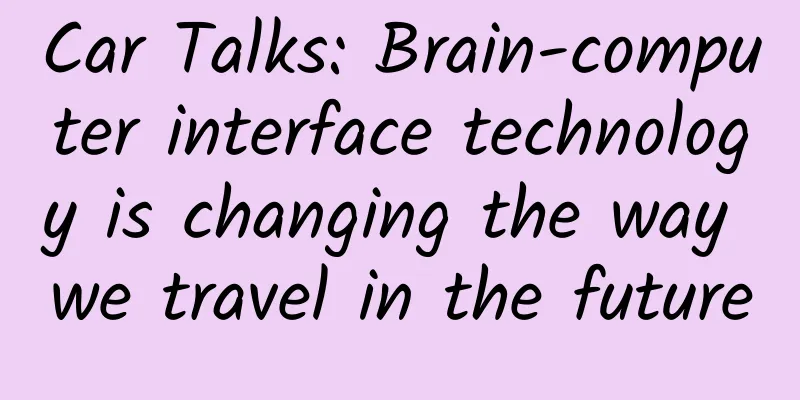Car Talks: Brain-computer interface technology is changing the way we travel in the future

|
In the classic sci-fi movie "The Matrix", the protagonists' brains are connected to computers through cables, so they can travel freely in the virtual world with their consciousness. In the movie "Alita: Battle Angel", the cyborg connects the brain nerves with the electronic device to realize the free control of the entire mechanical body with consciousness. When we thought that the sci-fi scenes depicted in these blockbuster movies could only appear on the screen, brain-computer interface technology has achieved many incredible results in the world's top laboratories, such as mind typing, consciousness communication, cochlear implants, etc. So, can brain-computer interface technology (BCI) bring revolutionary changes in the field of driverless driving? In this regard, Dr. Zhang Gang, a doctoral student in brain-computer interface research at the School of Medicine of Tsinghua University, said in the latest episode of "Knowing Cars Talks": "In the era of driverless cars, through brain-computer interface technology, vehicles are no longer just a simple tool, but can become people's intimate companions and better serve people. However, brain-controlled car technology is a difficult technology. At present, this technology is still in the accumulation stage and faces many scientific problems. The speed of human technological progress is unpredictable. We must enjoy technology and look forward to the future." Full speech Hello everyone. I am Zhang Gang, a speaker of Car Talk. My research direction is the driving control of unmanned vehicles by brain-computer interfaces. In the past research, I cooperated with universities and enterprises such as the National University of Defense Technology and Northern Industries to study the control of unmanned vehicles by brain-computer interfaces. What kind of research is this? In fact, it is not unfamiliar to everyone. For example, we have seen many movies and TV series, such as the stories of ancient Chinese immortals, in which people can control flying swords through consciousness, and such a technology is the brain-computer interface. Then there are some science fiction movies, such as The Matrix, in which people can do many things in an illusory dream through the technology of brain-computer interfaces. Free your hands, brain-computer interface technology provides more travel possibilities So what is brain-computer interface technology? Its professional term is BCI brain computer interface, and there is also a professional term called BMI: Brain machine interface. This technology actually establishes a communication between the brain and external devices. Then through this technology, the brain's consciousness signals can be directly transmitted to our surrounding devices for control. Doesn't it sound quite sci-fi? Currently, there are two major research directions in brain-computer interface technology. One is through implantable brain-computer interface, and the other is through wearable brain-computer interface. Musk's NeuralLink company is doing implantable brain-computer interface, and our laboratory is mainly working in the wearable direction. As early as 2002, we realized the control of external devices through wearable brain-computer interface. Why do we need to study the topic of brain-computer interface for unmanned vehicle driving? Beijing Union University has a special education college. There is a student named Cao Zhaoyu. He suffered from congenital myasthenia gravis at the age of 4, which made his movements very inconvenient. For such students, there are many things that they cannot achieve in their lives. For example, driving, I think in the era of artificial intelligence and unmanned driving, through the technology of brain-computer interface, students like him can drive cars to live a better life. To achieve barrier-free driving, the user's car needs can be understood at any time through the sensors on the user's body, and the car can be summoned to his side with the mind. Does it sound a bit like the professor in "X-Men"? People sitting in the car can control their own means of transportation only through the invisible and intangible thoughts in their heads. When the brain-computer interface car control technology is realized, the vehicle is no longer just a simple tool, but can become a close partner of people and serve people better. I think this kind of miracle that only exists in movies will come to our lives one day. When many people hear about this topic, their first reaction is, do we need to control the car with our mind? What is the significance of such technology except for special groups? Just imagine, when driving, have we ever felt drowsy, or have we ever forgotten where we parked the car in the parking lot? Then these problems are not a problem after realizing the technology of brain-computer interface control car. It can liberate people's hands and feet during driving, so that people can have time to do more other things during driving. Through the sensors installed on the head, you can easily obtain the user status of the person, and then judge whether your instructions are correct to avoid safety accidents. Provide users with a more comfortable driving environment. With the blessing of this technology, the vehicle will no longer be just a tool, but a partner who can understand you. When you need a vehicle, the car will appear in front of you anytime and anywhere. When driving, you only need to choose where you want to go through your brain, and you can do other things with peace of mind. If you need to stop or change the route on the way, you only need to use your brain. The future is here, it’s only a matter of time before brain-controlled car technology becomes a reality What is the principle of mind-controlled car? First, we need to obtain human brain electrical signals through the acquisition device of the brain-computer interface. This device can be like a hat, a piece of jewelry, or an implanted device like a button. The acquired data can be transmitted to the driving chip of our car, that is, the brain of the car, through wireless transmission. Then the car judges whether the driving instruction of the person is legal and complies with the driving rules, and then executes the driving instruction of the person. How is the technology of mind-controlled cars developing? As early as 2011, the autonomous project of the Free University of Berlin publicly demonstrated a car-control experiment based on imagined movements. In 2012, my mentor Professor Gao Xiaorong and Professor Sun Fuchun of the School of Information Science and Technology at Tsinghua University collaborated on research on mind-controlled unmanned vehicles. Nankai University and Beijing Institute of Technology also conducted experiments on mind-controlled cars in 2015. At present, the methods of realizing brain-controlled cars include imaginary movement, steady-state induction, p300, etc. For example, imaginary movement is achieved by imagining the left hand and right hand, left foot or right foot. Then I only need to imagine that I can use my left hand or right hand to make the car turn left or right. Steady-state induction is achieved through a visual stimulation button, which can be made in people's glasses or on your screen glass. Then when people focus on this target, it will induce brain movement signals. You can know which buttons the user sees and identify the person's intention. Brain-controlled car technology is a very difficult technology. At present, this technology is still in the accumulation stage and faces many scientific problems, such as how to apply brain-computer interfaces in complex driving environments, how to improve the reliability of brain-controlled car technology, and how to integrate the intelligence of people and cars when controlling cars with brains. From the perspective of the automotive industry, Nissan once demonstrated brain to vehicle at the 2019 Guangzhou Auto Show, which is a technology that improves people's reaction speed during driving. By acquiring brain signals, driving information is transmitted to the vehicle faster, allowing the vehicle to react faster. In other fields, Musk's Neurallink company released a simple experiment this year in which monkeys can play games through thoughts and get rewards such as banana smoothies. Although it is just a tribute to the start-up BCI experiment, the technology demonstrated cannot be underestimated. Several months of implantation time, stable transmission, implanting the electrode chip into the skull to reduce rejection, a small enough implant device, and obtaining good enough EEG data. This series of innovations and problem-solving ideas are worth learning. Neurallink will conduct experiments on humans next year. Musk has many technology companies under his name, the most famous of which is the manufacturer of Tesla's driverless electric cars. It is only a matter of time before brain-computer interfaces are applied to the driving of driverless cars. Since brain-controlled car technology needs to obtain human brain electrical signals, there is another common voice in the industry. Does this brain electrical data involve human privacy and ethical issues? When we get this data, when we use this data, when our consciousness is read, can our privacy still be protected, and how can this privacy data be protected? For the current brain-computer interface technology, it is not possible to control the human brain, so there is no need to worry about us being controlled by machines for the time being. Some people ask how far away this technology is from us? I cannot predict the speed of human technological progress, but I think some technologies may soon be applied to vehicle driving, such as barrier-free vehicle driving interaction through visual stimulation menus. Fatigue driving detection may appear in the freight industry to avoid fatigue driving, and obtain the driver's emotions through brain waves to determine whether the driving instructions are reasonable, etc. The widespread application of brain-computer interface technology, I think it will realize the control of the car after the realization of unmanned driving, that is, after 2035. In the next five to ten years, that is, after 2045, the control of cars with thoughts will appear widely in our lives. Enjoy technology and look forward to the future. That’s all I have to share today. I hope it can give you some food for thought. Thank you. As a winner of Toutiao's Qingyun Plan and Baijiahao's Bai+ Plan, the 2019 Baidu Digital Author of the Year, the Baijiahao's Most Popular Author in the Technology Field, the 2019 Sogou Technology and Culture Author, and the 2021 Baijiahao Quarterly Influential Creator, he has won many awards, including the 2013 Sohu Best Industry Media Person, the 2015 China New Media Entrepreneurship Competition Beijing Third Place, the 2015 Guangmang Experience Award, the 2015 China New Media Entrepreneurship Competition Finals Third Place, and the 2018 Baidu Dynamic Annual Powerful Celebrity. |
>>: Hisense will launch OLED TV and color TV competition will enter the high-end era
Recommend
As a product grows from 0 to 100, what is operations doing?
When I was in college, I started to get involved ...
How can TikTok newbies quickly increase their followers?
Video 0 playback & low playback and solutions...
China Passenger Car Association: In December 2024, the national passenger car manufacturers wholesaled 3.075 million vehicles, a year-on-year increase of 12.3% and a month-on-month increase of 4.5%
According to data released by the China Passenger...
Which industries is Baidu Information Flow suitable for? How to deliver?
Which industries are suitable for Baidu informati...
The latest news on the new epidemic in Suzhou in 2022: Will the city be closed? Attached is the latest official response!
In recent days, not only has the number of new inf...
This lousy "big-tailed wolf" of Buggy is actually a whale?
This year's species calendar includes many la...
What is the real reason for battery aging?
A recent Stanford University study on the behavio...
Jing Xiang-Business behind-the-scenes operation underlying architecture + 17-node strategic architecture + human nature operation
Course Catalog ├──17-node strategic structure | ├...
On this grassland in Sichuan, there are plateau sacred birds and the first wolf protection station
Ten years ago, on the Ruoergai grassland , herder...
How to analyze user thinking and do good brand marketing?
In the past, everyone has always talked about tra...
Milos training video
Milos training video resources introduction: Cour...
Electric car time-sharing rental: a tough piece of cake
Electric car time-sharing rental (also known as &...
How to create batches of short videos to sell goods on Douyin!
What we are going to talk about today is the crea...
The mini program is launched amazingly, but why do I think it is bad?
In the early morning of January 9, the WeChat min...









